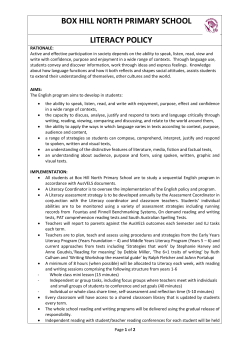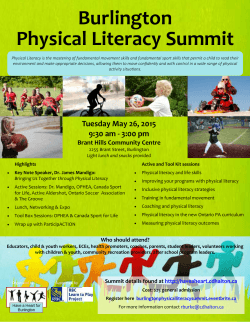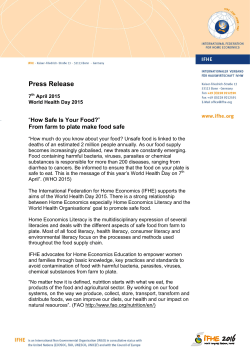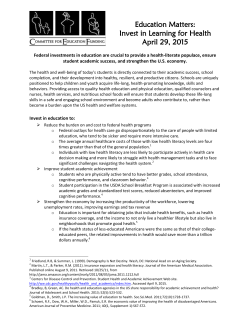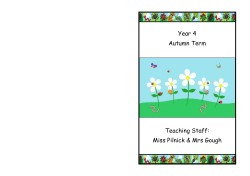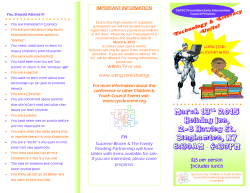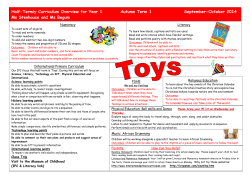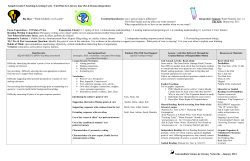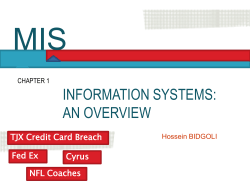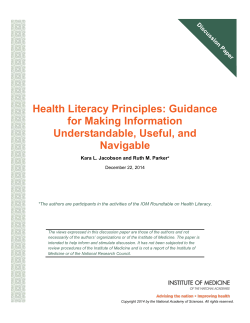
Year 4 ~ 2013 OLQP Greystanes Learning together for the future
Year 4 ~ 2013 OLQP Greystanes Learning together for the future Unity Partnership Between Home and School I dreamed I stood in a studio And watched two sculptors there The clay they used was a young child’s mind And they fashioned it with care. One was a teacher The tools they used were books and music and art One was a parent with a guiding hand and a gentle loving heart. Day after day the teacher toiled With touch that was loving and sure While the parent laboured by their side And polished and smoothed it o’er. And when at last their work was done They were proud of what they had wrought For the things they had worked into the child Could never be sold or bought. And each agreed they would have failed If they had worked alone For behind the parent stood the school And behind the teacher stood the home. Welcome to Year Four 2013 • Introducing the Year Four Teaching Team • 40 Miss Liezl Hipolito • 4L Miss Catherine Moses • 4Q Miss Rebecca Clancy • 4P Mrs Kym Romanous (Coordinator) • • • SUPPORT TEACHERS/ AIDES Mrs Nellie Musumeci Mrs Colleen Maunder “Our goal is to engage the children in their learning by promoting a collaborative community of learners. All children will be encouraged to achieve their full potential at their developmental stage by making choices in their learning across a range of intelligences. The children will be taught a range of cooperative learning strategies to promote collaboration. The Year Four Learning Team work collaboratively in planning, assessment and teaching.” A Day In Year Four 8:55 – 9:05 Class Routines ( Unpacking bags, roll, admin) Prayer 9:00 – 11:05am LITERACY • • • WRITING Text Types, Spelling, Grammar, Handwriting READING Shared Book, Comprehension, Readers Circle TALKING AND LISTENING RECESS 11:35- 12:05 RELIGION (Angelus 12:00pm) 12:05 – 12:15 Short Break 12:15 -1:15 NUMERACY Block 1:15 – 1:35 KLA – PDHPE/CREATIVE ARTS 1:35 – 1:45 – Eating Time in class LUNCH 2:15 – 3:05 INTEGRATED LEARNING incorporating HSIE, Science & Technology • Technology is incorporated into all Key Learning Areas. All students will regularly utilise the interactive whiteboard, laptops, Ipads, Ipods and digital cameras. Religious Literacy Assessment 2013 BACKGROUND : The Assessment of Religious Literacy project was part of a larger collaborative initiative, Partners in Learning, which had been established between the Catholic Education Office, Wollongong and Australian Catholic University (ACU). The goal of this project was for the ACU to assist the Diocese and schools in the area of assessing Religious Education in primary schools. An important element of the partnership was that parents, teachers, clergy and other groups were involved in documenting and sharing the good news about students' learning. Being religiously literate means students leave a Catholic primary school being able to communicate with, and be at home in, Catholic society and religion in general. Purpose of Religious Literacy Assessment • The purpose of the assessment is: • to profile and understand the extent and level of religious literacy with regard to students’ learning across Stages 1 and 2. • to enable students to show not only what they have achieved, but also demonstrate their ability to work with and apply what they have learnt. • to further facilitate and celebrate the concept of project based learning in the classroom (students’ personal choice based on individual strengths) Structure of Religious Literacy Assessment • The Religious Literacy Assessment is completed in two sections at school during Term 3. • Part A – An online Assessment consisting of 35 Multiple Choice questions assessing Stage 1 and Stage 2 outcomes and content in RE • Part B – Project Based Task – Based on the unit “Reconciliation – God’s Forgiveness and Healing”. Literacy: Reading the key focus for 2013 All students experience a balanced and coherent program of literacy instruction for a minimum of 100 minutes daily, incorporating: Purposeful Talk • Students will: participate in purposeful talk opportunities that are integrated throughout all reading and writing opportunities Daily Reading Aloud to Students (5-10mins) • students listen as teachers model a love of literature and passion for reading • students listen while teachers model proficient reading as they read and re-read a range of texts Daily Shared Reading (10-15mins) • students engage in explicitly-planned and focused shared reading sessions that have a specific learning intention - eg, comprehension strategies, concepts of print, phonemic awareness, vocabulary, phrasing and fluency, etc. • students listen and engage with teachers as they model proficient reading through, for example, think-aloud sessions Literacy: Reading the key focus for 2013 Readers Circle (20-30 mins at least once a week, at least 3x week for vulnerable students) • students are in flexible, needs-based groups (determined by analysis of running records) • students read texts that are at an instructional level which have been carefully selected to provide opportunities for guided instruction and practice of targeted skills and strategies. Daily Independent Reading of familiar texts (5-10 mins) • students read and re-read a range of texts - including familiar texts and books of their own choice How is Mathematics taught in Year Four? • Mathematics is taught daily in the form of a 60 minute Numeracy Block. The session begins with a 5 minute Warm – Up (Number based). This is followed by an Investigation. This usually consists of ‘Rich Task’ focusing on one or more mathematical concepts. To conclude the session there is reflection and sharing time to discuss strategies and mathematical thinking. • Children are given a variety of learning experiences involving concrete materials. This allows for the natural progression from concrete to abstract understandings. • We use challenging real life problems that are open ended in nature eg. How many ways can you represent the number 3605? The answer may be represented by materials, a problem posed by the student, symbols, words, pictures. • There is a focus on children’s thinking and strategies not just the answer. • There is a focus on mental strategies eg. 35 + 44 = 30 + 40 + 5 + 4 =79 eg. 75 - 32 = 75 - 30 = 45 and then 45 - 2 = 43 • There is a lot of group work, partner work and peer tutoring. • Number busting activity Reporting • In Year Four, the children are allocated grades on an E to A scale in accordance with government guidelines. • • • • • E- Elementary Achievement, experiencing difficulty and requires support to complete tasks D- Basic Achievement - working towards grade level C- Sound Achievement - achieving at grade level. B- High Achievement - achieving beyond grade level A- Excellent Achievement -achieving well beyond grade level • The majority of children will achieve a C grade which is considered working at grade level. • • The Half yearly report is based on the first half of the year. The End of year report is based on the second half of the year. • The grades are given to children based on assessment tasks, class contributions and observations of their day to day learning. Homework The Homework Grid •Homework will take the form of a grid, allowing the students to select activities which further develop academic, social and physical skills. •Over a two week period the students are expected to complete a total of 8 activities (two per area) in addition to daily reading, spelling and number fact revision. •Parents are encouraged to check and sign grid sheet prior to submission. Monday Tuesday Reading (10min) Spelling (10 min) Times Tables4X and 8X (5 min) Wednesday Thursday PHYSICAL ACTIVITY MATHS Participate in an organised sport. (Swimming lessons, soccer training, tennis etc) Play a skipping game for 10 minutes. Choose 5 two digit numbers and construct factor trees for them. (20 min) Use the numbers 2, 5, 8 and 3 and make 5 two-digit multiplication algorithms. Work them out. (20 min) Have physical fun – play outside for an hour Spend some time doing some exercise. (15 Min) Monday Tuesday CULTURAL Research information about the Paralympics. List 5 interesting facts about the event. (15 min) Draw a comic strip explaining something about the human body. You can make it as funny as you like. (30 min) Teach someone in your family your Research a musical instrument. Tell times tables. (15 min) me 5 interesting facts about this instrument. (20 min) Choose 5 two digit numbers. Tell me Draw the character you dressed up as the factors of these numbers (20 min) from book week. Tell me which book they are from and why you chose this character (20 min) Wednesday Thursday GENERAL List what you could do if you were being bullied at school. Give 5 strategies. (10min) Do 10 mins of housework Read a fable. Explain the meaning of the fable you read. (15 min) Spend some time playing a game with a friend or family member. (20 min) How Can I help my Child at home? • Listen to your child read, encourage them to also read silently for an extended period of time. Ask your child to retell what they have read. Children who are read to from the earliest age and those who enjoy recreational reading are usually very effective learners. Provide a variety of texts for your child to read to you such as stories, comics, poems, plays, magazines, cartoons, recipe books. • Play games together - card games, computer games and discuss the mathematical ideas that can be used to play. Cook together look at measurements, digital time, analog time also fractions when cutting up a cake. Encourage your child to use money, visit the local shops together and look at best value for money. • Encourage them to become independent with their homework. Establish a routine for completing the homework. The children will have a two week period to complete the homework. Just be mindful that the spelling really should be completed each day, rather than all at once. The rest of the homework could be completed at their own pace. How Can I help my Child at home? • Foster good relations between home and school, children tend to do better at school when they see their parents and teachers supporting each other and sharing common expectations. • PRAISE, PRAISE, PRAISE!!!! Self confident children tend to do well. Tell them how great their work is. Have high but realistic expectations. Encourage them to try their best and build their confidence. Make them feel great about their achievements! • Have a policy on how much time is given to the TV and the computer. Ensure that plenty of time is available for play, hobbies, exercise and family conversations. • Aspects of this taken from CEO Parramatta website Ten Ways to Help Your Child Succeed at School. Student Management • At Our Lady Queen of Peace, all of our teaching is based on the Gospel values of Jesus. • It is imperative that children are taught to respect themselves, each other, teaching staff and the school property if we are to maintain a cooperative Christian community based on Gospel values. We ask that all parents be supportive of school policies in regards to behaviour. • All children are expected to follow the school and class rules at all times. When children have made poor choices, we follow the Restorative Justice procedures where children are asked to identify what mistake they had made and how they could rectify that mistake. This is guided by a teacher. • Any issues your child may have with another child must be dealt with by the school. Please consult your child’s teacher if you have a concern. Parent / Teacher contact • If you have any questions or concerns throughout the year, the first thing to do is to speak to your child’s teacher directly. Either send in a note, ring the office to make an appointment or drop in and see us before or after school. • Throughout the year we will be calling for parent volunteers for excursions or to help in the classroom. If you would like to become an active member of the Year Four Learning Community, please make sure your Child Protection Training is up to date. This training is now available online and must be renewed every year.
© Copyright 2025
